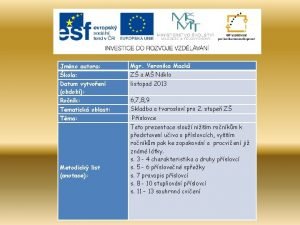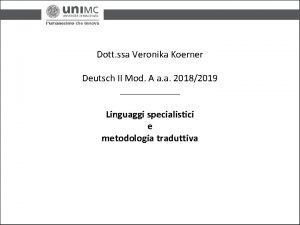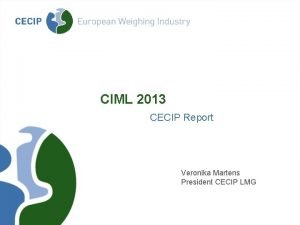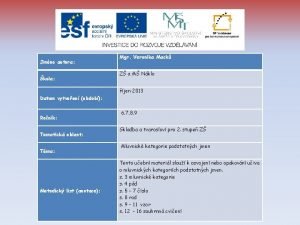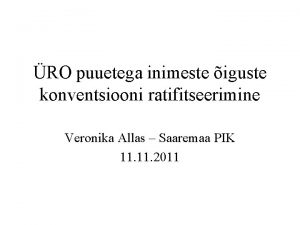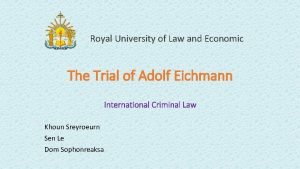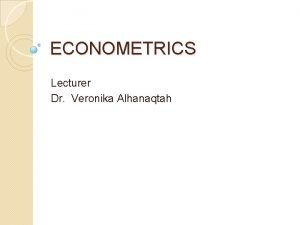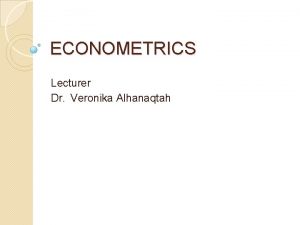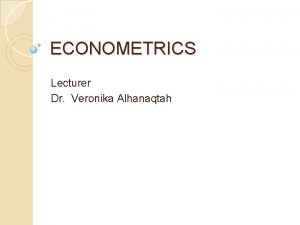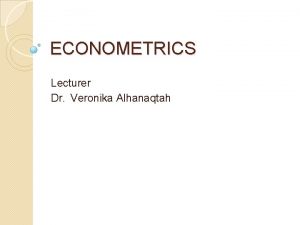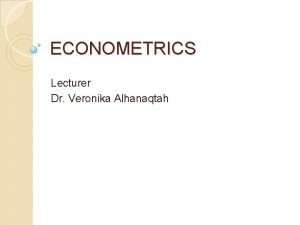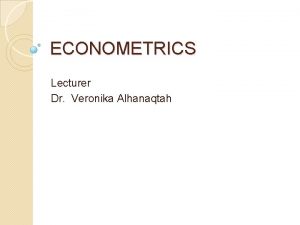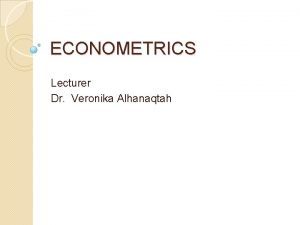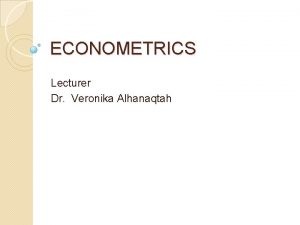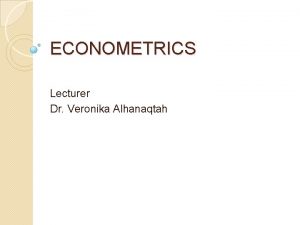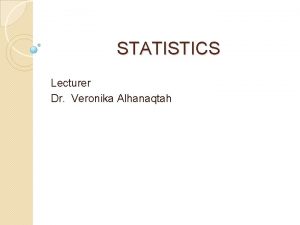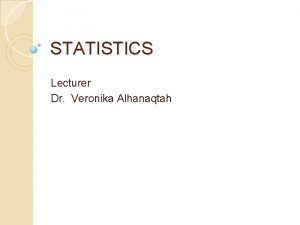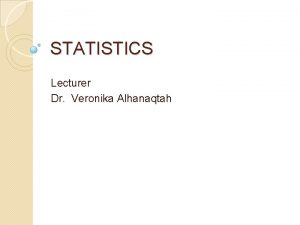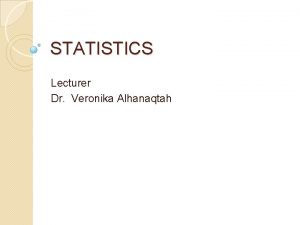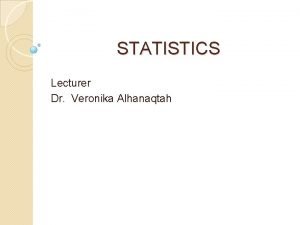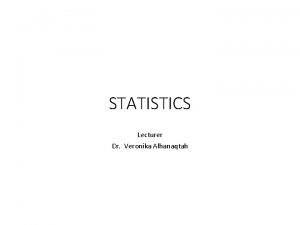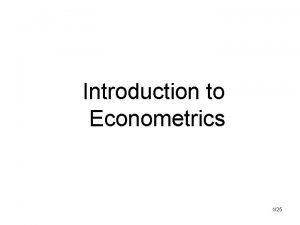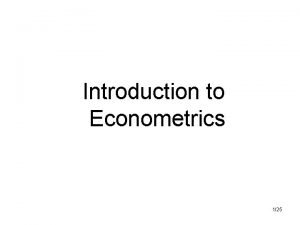ECONOMETRICS Lecturer Dr Veronika Alhanaqtah Topic 4 3


































- Slides: 34

ECONOMETRICS Lecturer Dr. Veronika Alhanaqtah

Topic 4. 3. Problems when building multiple linear Topic 4. 3. regression with the least square method: Autocorrelation � Nature of autocorrelation Autocorrelation of the first order � Consequences of autocorrelation � Correction of autocorrelation: Robust standard errors � Detecting of autocorrelation ◦ Graphical analysis of residuals ◦ The Durbin-Watson test ◦ The Breusch-Godfrey test �

OLS assumptions and Gauss-Markov theorem �

1. Nature of autocorrelation 1. �

1. Nature of autocorrelation 1. �

1. Nature of autocorrelation 1. � Y Summer Winter X

1. Nature of autocorrelation 1. Example of negative autocorrelation: � Negative autocorrelation means that positive deviation is followed by the negative deviation, and vice versa. � This situation can happen when we analyze the same relationship, as above, but use seasonal data (winter – summer). �

1. Nature of autocorrelation 1. Reasons of autocorrelation: � mistakes in model specification time lag in change of economic parameters � web-effect � data smoothing �

1. Reasons of autocorrelation 1. Reasons �

1. Reasons of autocorrelation 1. Reasons Time lag. Many economic parameters are cyclical, as a consequence of undulating economic cycles. Changes doesn’t happen immediately. It takes some time or a time lag. � Web-effect. In many spheres of economic activity, parameters react to changes of economic conditions with delay, or time lag. For example, supply of agricultural products react to price changes with delay (equal to the agricultural season). High price of agricultural products in the previous year, most likely, leads to effect of its overproduction in the current year, and, as a consequence, the price will decrease, and so on. In this case, deviation of residuals from each other is not accidental (or random). � Data smoothing. Very often the data over some long period of time are averaged along the subintervals. To smooth a data set is to create an approximating function that attempts to capture important patterns in the data, while leaving out noise or other fine-scale structures. �

1. Reasons of autocorrelation 1. Reasons �

1. Reasons of autocorrelation 1. Reasons Autocorrelation is examined in details: � time series analysis; spatial econometrics; � panel data. � These are almost independent disciplines.

2. Autocorrelation of the first order Autocorrelation may have very complicated structure: AR, MA, ARIMA, VAR, VMA, VARMA, VECM, ARCH, GARCH, EGARCH, FIGARCH, TARCH, AVARCH, ZARCH, CCC, DCC, BEKK, VEC, DLM ….

2. Autocorrelation of the first order �

2. Autocorrelation of the first order �

2. Autocorrelation of the first order �

3. Consequences of autocorrelation �

3. Consequences of autocorrelation �

4. Correction of autocorrelation: robust standard errors �

4. Correction of autocorrelation: robust standard errors � Great!

4. Correction of autocorrelation: robust standard errors �

4. Correction of autocorrelation: robust standard errors In practice: (1) Estimate a model as usual: model<-lm(data=data, y~x+z) (2) Compute robust covariance matrix (“sandwich” package) vcov. HAC(model) (3) Use robust covariance matrix for hypothesis testing (“lmtest” package) coeftest(model, vcov. =vcov. HAC)

4. Correction of autocorrelation: robust standard errors When is it advisable to use robust covariance matrix and robust standard errors? In cases when we suspect presence of autocorrelation and do not want to model its structure (structure of relationship between residuals). For example, in time series or in data where there is geographical closeness between observations.

5. Detecting autocorrelation 5. 1. Graphical analysis of residuals �

5. Detecting autocorrelation 5. 2. The Durbin-Watson test �

5. Detecting autocorrelation 5. 2. The Durbin-Watson test �

5. Detecting autocorrelation 5. 2. The Durbin-Watson test �

5. Detecting autocorrelation 5. 2. The Durbin-Watson test �

5. Detecting autocorrelation 5. 3. The Breusch-Godfrey test �

5. Detecting autocorrelation 5. 3. The Breusch-Godfrey test �

5. Detecting autocorrelation 5. 3. The Breusch-Godfrey test �

5. Detecting autocorrelation �

Autocorrelation �

Homework Visit instructor’s web-page on Econometrics. www. alveronika. wordpress. com � Homework “Autocorrelation” (exemplary exam test). � Print out “Handout. Topic 5” for the next lesson. �
 Lecturer's name or lecturer name
Lecturer's name or lecturer name Photography lecturer
Photography lecturer Gcwak
Gcwak Jeannie watkins
Jeannie watkins Lecturer asad ali
Lecturer asad ali Lector vs lecturer
Lector vs lecturer Lecturer in charge
Lecturer in charge Lecturer name
Lecturer name Spe distinguished lecturer
Spe distinguished lecturer Lecturer in charge
Lecturer in charge Designation lecturer
Designation lecturer Pearson lecturer resources
Pearson lecturer resources Teacher good afternoon
Teacher good afternoon Cfa lecturer handbook
Cfa lecturer handbook Designation of lecturer
Designation of lecturer 140000/120
140000/120 Unity and coherence
Unity and coherence /topic/ down
/topic/ down Veronika macků
Veronika macků Veronika bajt
Veronika bajt Veronika margaret
Veronika margaret Veronika fuchsová
Veronika fuchsová Veronika grob
Veronika grob Ivanova veronika
Ivanova veronika Veronika remisova
Veronika remisova Veronika körner
Veronika körner Unset message veronika
Unset message veronika Veronika martens
Veronika martens Veronika macků
Veronika macků Veronika velkova
Veronika velkova Hublov
Hublov Veronika allas
Veronika allas Lisa roos nude
Lisa roos nude Veronika součková zpěv
Veronika součková zpěv Veronika lieblová
Veronika lieblová


















